A Comprehensive Analysis of Amazon's Supply Chain Management (Report)
VerifiedAdded on 2023/01/04
|17
|4637
|46
Report
AI Summary
This report provides a comprehensive analysis of Amazon's supply chain management, examining its key elements and practices. The study begins with an executive summary and introduction, setting the stage for an in-depth exploration of Amazon's supply network. It critically analyzes current supply network management, highlighting strengths such as efficient forecasting, purchasing, and inventory management, while also identifying areas for improvement, particularly in business sustainability compared to industry peers like Apple and Wal-Mart. The report delves into specific elements, including forecasting techniques, purchasing strategies, outsourcing practices, inventory management, lean and agile management approaches, distribution systems, the application of Six Sigma, and the integration of sustainable supply chain principles. The analysis covers various structural levels of Amazon's supply chain operations, from pre-structural to critical levels, emphasizing the company's ability to leverage technology and manage a vast inventory. The report concludes with implications, consequences of the research, and recommendations for enhancing Amazon's supply chain efficiency and sustainability. The report also mentions that Amazon uses both Push/Pull strategy for its inventory management and Vendor Managed Inventory to avoid the negative consequences of outsourcing inventory management.
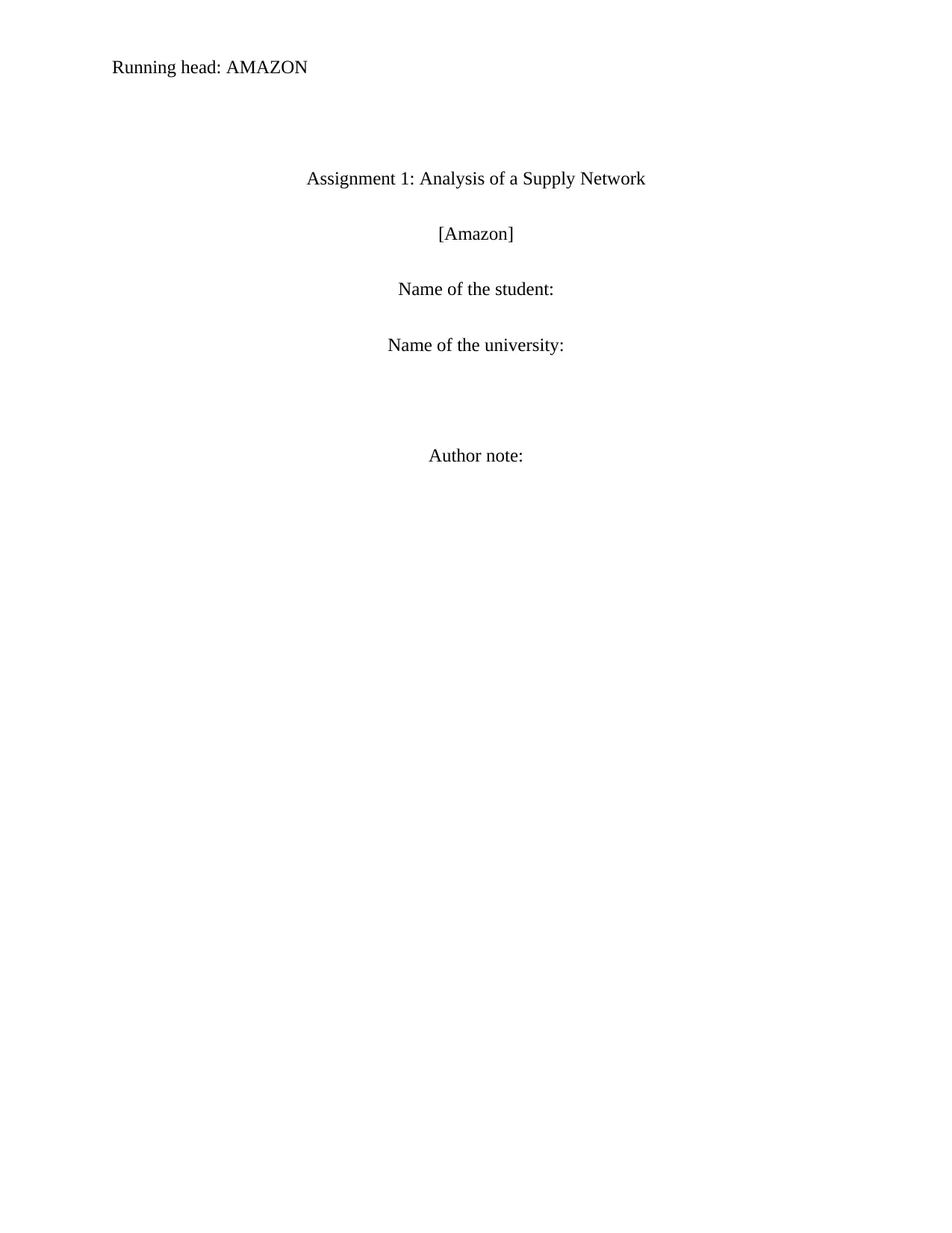
Running head: AMAZON
Assignment 1: Analysis of a Supply Network
[Amazon]
Name of the student:
Name of the university:
Author note:
Assignment 1: Analysis of a Supply Network
[Amazon]
Name of the student:
Name of the university:
Author note:
Paraphrase This Document
Need a fresh take? Get an instant paraphrase of this document with our AI Paraphraser
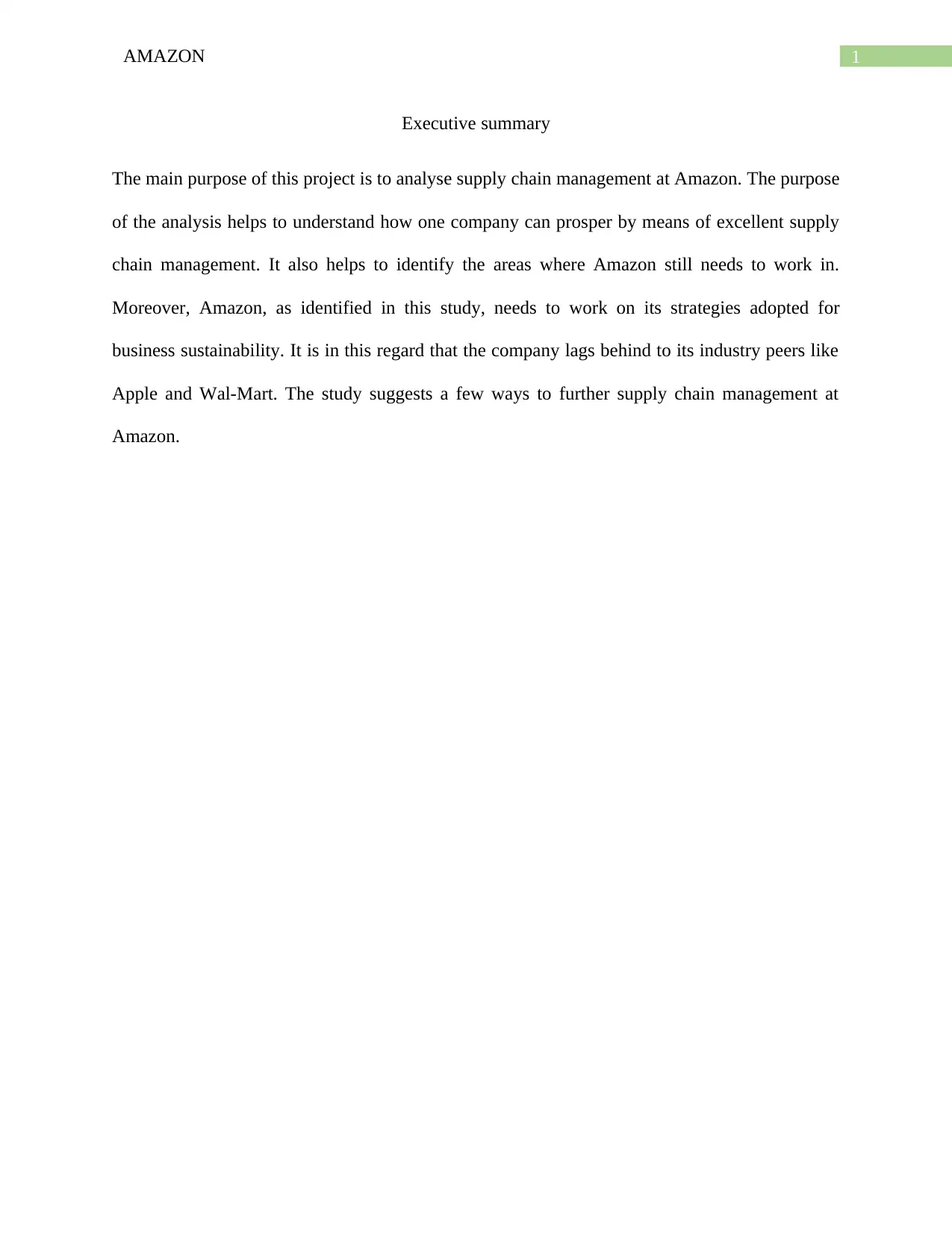
1AMAZON
Executive summary
The main purpose of this project is to analyse supply chain management at Amazon. The purpose
of the analysis helps to understand how one company can prosper by means of excellent supply
chain management. It also helps to identify the areas where Amazon still needs to work in.
Moreover, Amazon, as identified in this study, needs to work on its strategies adopted for
business sustainability. It is in this regard that the company lags behind to its industry peers like
Apple and Wal-Mart. The study suggests a few ways to further supply chain management at
Amazon.
Executive summary
The main purpose of this project is to analyse supply chain management at Amazon. The purpose
of the analysis helps to understand how one company can prosper by means of excellent supply
chain management. It also helps to identify the areas where Amazon still needs to work in.
Moreover, Amazon, as identified in this study, needs to work on its strategies adopted for
business sustainability. It is in this regard that the company lags behind to its industry peers like
Apple and Wal-Mart. The study suggests a few ways to further supply chain management at
Amazon.

2AMAZON
Table of Contents
1. Introduction..................................................................................................................................3
2. A critical analysis of current supply network management, its strengths and weaknesses.........3
2.1 A brief introduction to the supply chain practices in Amazon..............................................3
2.2 Key elements.........................................................................................................................4
Forecasting:..............................................................................................................................4
Purchasing:..............................................................................................................................5
Outsourcing..............................................................................................................................6
Inventory management:...........................................................................................................7
Lean management:...................................................................................................................8
Agile management:..................................................................................................................9
Distribution system:.................................................................................................................9
Six Sigma:..............................................................................................................................10
Sustainable supply chain:......................................................................................................11
3. Conclusions, implications and consequences of the research...................................................12
References......................................................................................................................................14
Table of Contents
1. Introduction..................................................................................................................................3
2. A critical analysis of current supply network management, its strengths and weaknesses.........3
2.1 A brief introduction to the supply chain practices in Amazon..............................................3
2.2 Key elements.........................................................................................................................4
Forecasting:..............................................................................................................................4
Purchasing:..............................................................................................................................5
Outsourcing..............................................................................................................................6
Inventory management:...........................................................................................................7
Lean management:...................................................................................................................8
Agile management:..................................................................................................................9
Distribution system:.................................................................................................................9
Six Sigma:..............................................................................................................................10
Sustainable supply chain:......................................................................................................11
3. Conclusions, implications and consequences of the research...................................................12
References......................................................................................................................................14
⊘ This is a preview!⊘
Do you want full access?
Subscribe today to unlock all pages.

Trusted by 1+ million students worldwide

3AMAZON
1. Introduction
Supply chain operations is an integral and vital part of the business. Without having a
robust supply chain and an utmost control on this a business whether small or big can never be
able to fulfill the market demands of the business. Every single company tries to apply the
various supply chain management principles and practices to be able to deliver their products and
services in a quicker time. However, the degree of experimentation with these policies and
practices differ from one to another company. The degree of variation comes due to the financial,
capital and innovating capability of the business that varies from one to another firm. Some of
the widely known principles and practices of the supply chain management are like inventory
management, lean management, agile management, push and pull factors, purchasing,
outsourcing, forecasting, distribution, six sigma and sustainable supply chain (Hugos, 2018).
The main purpose of this assignment is to analyse the supply chain management practices
in Amazon. Moreover, the project also seeks to identify whether the company faces any
challenges in regards to its supply chain management practices. If needed this paper will also
recommend a few points of suggestions to further the efficiency of the supply chain operations in
Amazon.
2. A critical analysis of current supply network management, its strengths and weaknesses
2.1 A brief introduction to the supply chain practices in Amazon
Amazon.com, Inc. is an American multinational company, which is widely known as one
of the most popular e-commerce businesses in the world (Amazon.com, 2019). The company has
excelled in identifying the potentiality of emerging technologies and implementing these pieces
of technology to enhance its efficiency and to be able to deliver orders at a record quicker pace.
1. Introduction
Supply chain operations is an integral and vital part of the business. Without having a
robust supply chain and an utmost control on this a business whether small or big can never be
able to fulfill the market demands of the business. Every single company tries to apply the
various supply chain management principles and practices to be able to deliver their products and
services in a quicker time. However, the degree of experimentation with these policies and
practices differ from one to another company. The degree of variation comes due to the financial,
capital and innovating capability of the business that varies from one to another firm. Some of
the widely known principles and practices of the supply chain management are like inventory
management, lean management, agile management, push and pull factors, purchasing,
outsourcing, forecasting, distribution, six sigma and sustainable supply chain (Hugos, 2018).
The main purpose of this assignment is to analyse the supply chain management practices
in Amazon. Moreover, the project also seeks to identify whether the company faces any
challenges in regards to its supply chain management practices. If needed this paper will also
recommend a few points of suggestions to further the efficiency of the supply chain operations in
Amazon.
2. A critical analysis of current supply network management, its strengths and weaknesses
2.1 A brief introduction to the supply chain practices in Amazon
Amazon.com, Inc. is an American multinational company, which is widely known as one
of the most popular e-commerce businesses in the world (Amazon.com, 2019). The company has
excelled in identifying the potentiality of emerging technologies and implementing these pieces
of technology to enhance its efficiency and to be able to deliver orders at a record quicker pace.
Paraphrase This Document
Need a fresh take? Get an instant paraphrase of this document with our AI Paraphraser
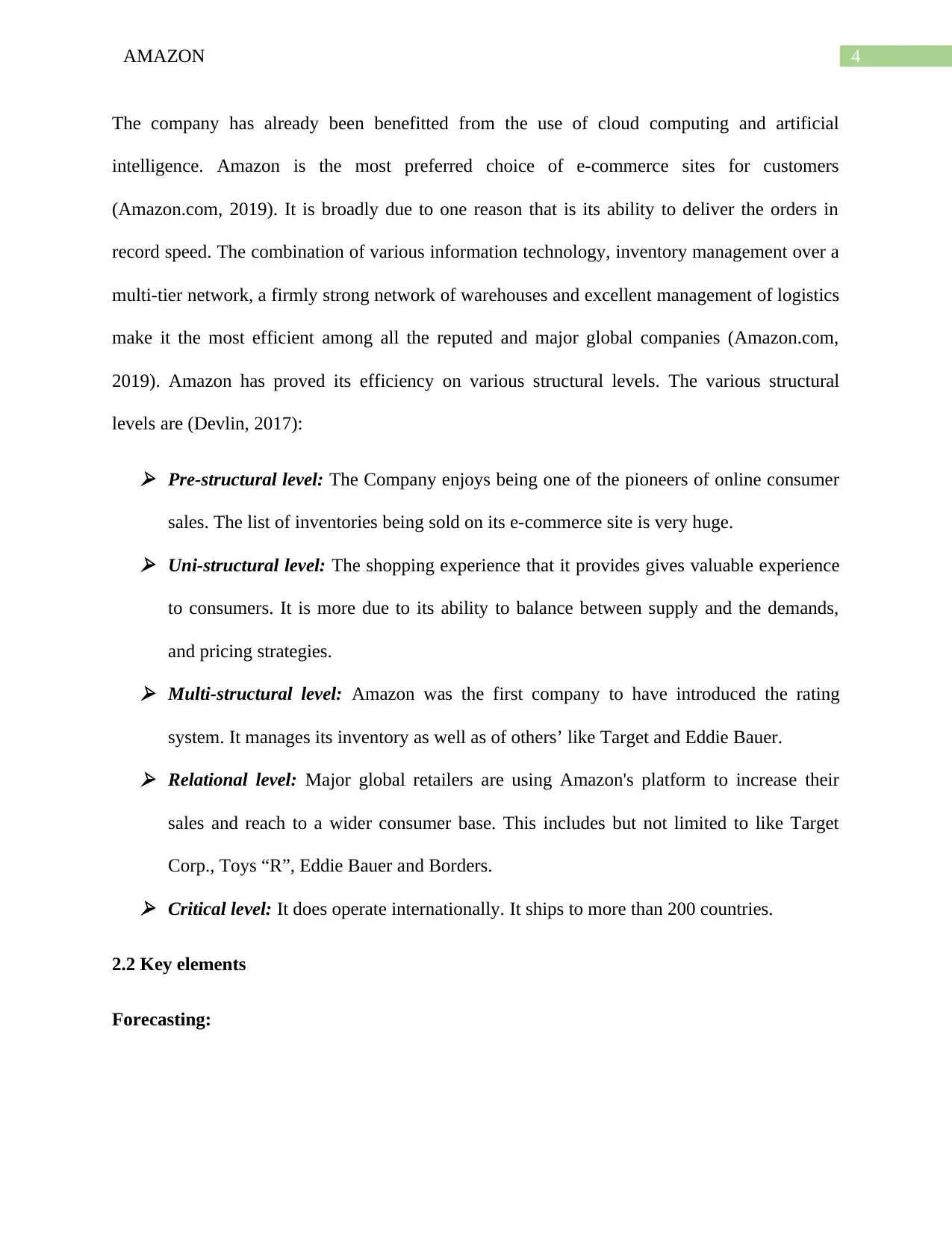
4AMAZON
The company has already been benefitted from the use of cloud computing and artificial
intelligence. Amazon is the most preferred choice of e-commerce sites for customers
(Amazon.com, 2019). It is broadly due to one reason that is its ability to deliver the orders in
record speed. The combination of various information technology, inventory management over a
multi-tier network, a firmly strong network of warehouses and excellent management of logistics
make it the most efficient among all the reputed and major global companies (Amazon.com,
2019). Amazon has proved its efficiency on various structural levels. The various structural
levels are (Devlin, 2017):
Pre-structural level: The Company enjoys being one of the pioneers of online consumer
sales. The list of inventories being sold on its e-commerce site is very huge. Uni-structural level: The shopping experience that it provides gives valuable experience
to consumers. It is more due to its ability to balance between supply and the demands,
and pricing strategies. Multi-structural level: Amazon was the first company to have introduced the rating
system. It manages its inventory as well as of others’ like Target and Eddie Bauer. Relational level: Major global retailers are using Amazon's platform to increase their
sales and reach to a wider consumer base. This includes but not limited to like Target
Corp., Toys “R”, Eddie Bauer and Borders. Critical level: It does operate internationally. It ships to more than 200 countries.
2.2 Key elements
Forecasting:
The company has already been benefitted from the use of cloud computing and artificial
intelligence. Amazon is the most preferred choice of e-commerce sites for customers
(Amazon.com, 2019). It is broadly due to one reason that is its ability to deliver the orders in
record speed. The combination of various information technology, inventory management over a
multi-tier network, a firmly strong network of warehouses and excellent management of logistics
make it the most efficient among all the reputed and major global companies (Amazon.com,
2019). Amazon has proved its efficiency on various structural levels. The various structural
levels are (Devlin, 2017):
Pre-structural level: The Company enjoys being one of the pioneers of online consumer
sales. The list of inventories being sold on its e-commerce site is very huge. Uni-structural level: The shopping experience that it provides gives valuable experience
to consumers. It is more due to its ability to balance between supply and the demands,
and pricing strategies. Multi-structural level: Amazon was the first company to have introduced the rating
system. It manages its inventory as well as of others’ like Target and Eddie Bauer. Relational level: Major global retailers are using Amazon's platform to increase their
sales and reach to a wider consumer base. This includes but not limited to like Target
Corp., Toys “R”, Eddie Bauer and Borders. Critical level: It does operate internationally. It ships to more than 200 countries.
2.2 Key elements
Forecasting:
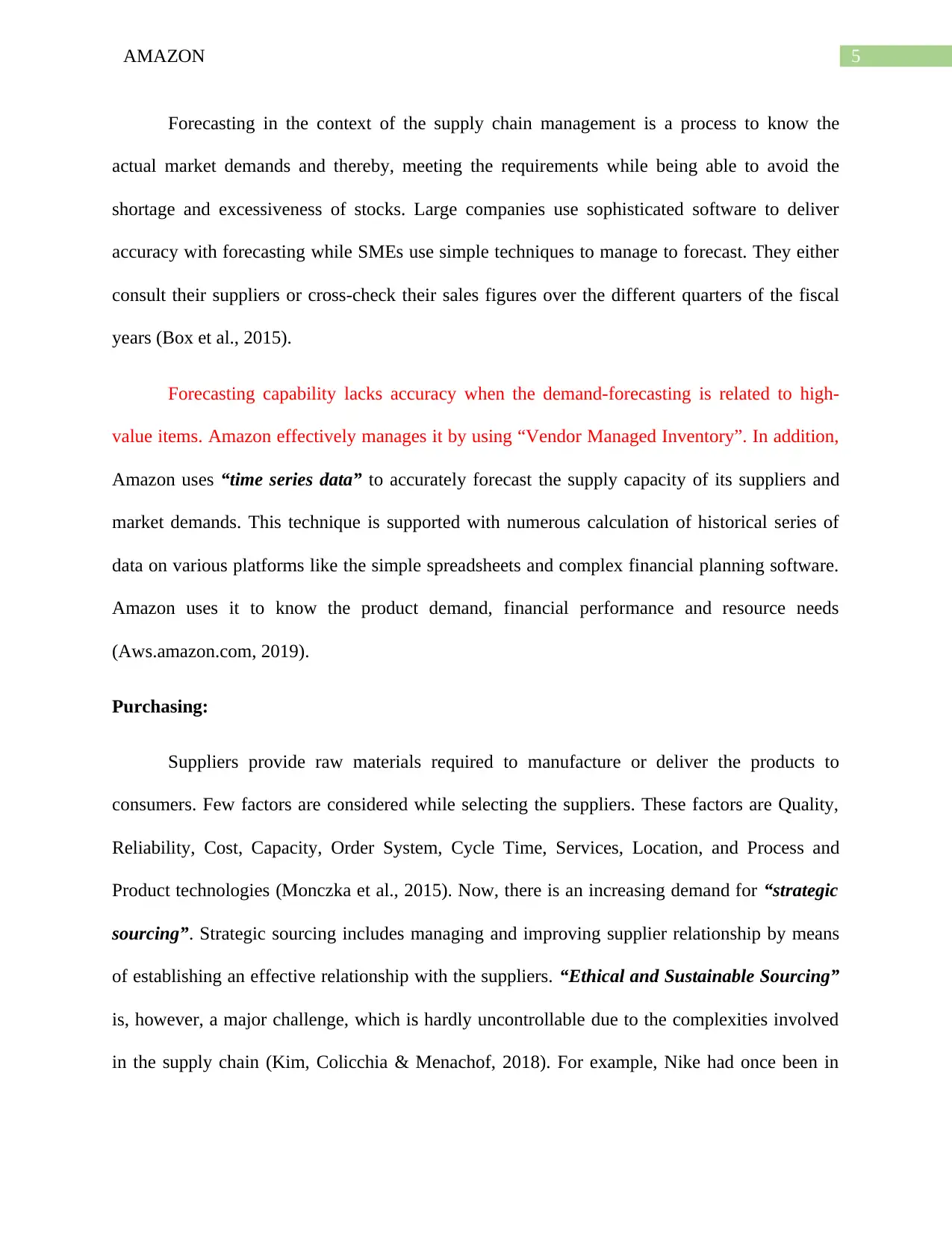
5AMAZON
Forecasting in the context of the supply chain management is a process to know the
actual market demands and thereby, meeting the requirements while being able to avoid the
shortage and excessiveness of stocks. Large companies use sophisticated software to deliver
accuracy with forecasting while SMEs use simple techniques to manage to forecast. They either
consult their suppliers or cross-check their sales figures over the different quarters of the fiscal
years (Box et al., 2015).
Forecasting capability lacks accuracy when the demand-forecasting is related to high-
value items. Amazon effectively manages it by using “Vendor Managed Inventory”. In addition,
Amazon uses “time series data” to accurately forecast the supply capacity of its suppliers and
market demands. This technique is supported with numerous calculation of historical series of
data on various platforms like the simple spreadsheets and complex financial planning software.
Amazon uses it to know the product demand, financial performance and resource needs
(Aws.amazon.com, 2019).
Purchasing:
Suppliers provide raw materials required to manufacture or deliver the products to
consumers. Few factors are considered while selecting the suppliers. These factors are Quality,
Reliability, Cost, Capacity, Order System, Cycle Time, Services, Location, and Process and
Product technologies (Monczka et al., 2015). Now, there is an increasing demand for “strategic
sourcing”. Strategic sourcing includes managing and improving supplier relationship by means
of establishing an effective relationship with the suppliers. “Ethical and Sustainable Sourcing”
is, however, a major challenge, which is hardly uncontrollable due to the complexities involved
in the supply chain (Kim, Colicchia & Menachof, 2018). For example, Nike had once been in
Forecasting in the context of the supply chain management is a process to know the
actual market demands and thereby, meeting the requirements while being able to avoid the
shortage and excessiveness of stocks. Large companies use sophisticated software to deliver
accuracy with forecasting while SMEs use simple techniques to manage to forecast. They either
consult their suppliers or cross-check their sales figures over the different quarters of the fiscal
years (Box et al., 2015).
Forecasting capability lacks accuracy when the demand-forecasting is related to high-
value items. Amazon effectively manages it by using “Vendor Managed Inventory”. In addition,
Amazon uses “time series data” to accurately forecast the supply capacity of its suppliers and
market demands. This technique is supported with numerous calculation of historical series of
data on various platforms like the simple spreadsheets and complex financial planning software.
Amazon uses it to know the product demand, financial performance and resource needs
(Aws.amazon.com, 2019).
Purchasing:
Suppliers provide raw materials required to manufacture or deliver the products to
consumers. Few factors are considered while selecting the suppliers. These factors are Quality,
Reliability, Cost, Capacity, Order System, Cycle Time, Services, Location, and Process and
Product technologies (Monczka et al., 2015). Now, there is an increasing demand for “strategic
sourcing”. Strategic sourcing includes managing and improving supplier relationship by means
of establishing an effective relationship with the suppliers. “Ethical and Sustainable Sourcing”
is, however, a major challenge, which is hardly uncontrollable due to the complexities involved
in the supply chain (Kim, Colicchia & Menachof, 2018). For example, Nike had once been in
⊘ This is a preview!⊘
Do you want full access?
Subscribe today to unlock all pages.

Trusted by 1+ million students worldwide

6AMAZON
criticism for the child labour. The company receives its raw materials from a variety of footwear
and apparel factories (Delaney et al., 2016).
Amazon uses a platform to efficiently conduct B2B procurement process. However, there
are still few inefficiencies such as ineffective time management. This is mostly consumed in the
assessments, checklists and approvals for raw materials and the payment. To overcome this issue
Amazon uses different dealing mechanism with a variety of suppliers. The business is now price-
savings and fast as well. The shipment process is easy. Amazon uses flexible payment options,
multi-user accounts and a range of product options. Some newly added features include
catalogue curation, paying by invoice and Coupa Open Buy (Zhu & Liu, 2018). Amazon also
uses procurement software; however, it is very expensive (Zhu & Liu, 2018).
Outsourcing
Outsourcing is about getting all or parts of the work done from the suppliers. It is
believed as a cost-cutting process. Some companies like Apple also use offshoring, which they
mostly do by working with suppliers in the target country (Tate & Bals, 2017). Some companies
are now preferring reshoring, which is opposite in meaning from offshoring. Apple, General
Motors, Whirlpool, GE, Walmart, Microsoft, Ford and Caterpillar have considered reshoring a
part of their manufacturing to North America (Tate & Bals, 2017).
Amazon does outsource its inventory. The decision to go with this strategy was based on
a few points. These are (Lincoln & Andrew, 2018):
Reduced redundant inventory
Low inventory turnover
To increase the cost of holding from the cost of outsourcing
criticism for the child labour. The company receives its raw materials from a variety of footwear
and apparel factories (Delaney et al., 2016).
Amazon uses a platform to efficiently conduct B2B procurement process. However, there
are still few inefficiencies such as ineffective time management. This is mostly consumed in the
assessments, checklists and approvals for raw materials and the payment. To overcome this issue
Amazon uses different dealing mechanism with a variety of suppliers. The business is now price-
savings and fast as well. The shipment process is easy. Amazon uses flexible payment options,
multi-user accounts and a range of product options. Some newly added features include
catalogue curation, paying by invoice and Coupa Open Buy (Zhu & Liu, 2018). Amazon also
uses procurement software; however, it is very expensive (Zhu & Liu, 2018).
Outsourcing
Outsourcing is about getting all or parts of the work done from the suppliers. It is
believed as a cost-cutting process. Some companies like Apple also use offshoring, which they
mostly do by working with suppliers in the target country (Tate & Bals, 2017). Some companies
are now preferring reshoring, which is opposite in meaning from offshoring. Apple, General
Motors, Whirlpool, GE, Walmart, Microsoft, Ford and Caterpillar have considered reshoring a
part of their manufacturing to North America (Tate & Bals, 2017).
Amazon does outsource its inventory. The decision to go with this strategy was based on
a few points. These are (Lincoln & Andrew, 2018):
Reduced redundant inventory
Low inventory turnover
To increase the cost of holding from the cost of outsourcing
Paraphrase This Document
Need a fresh take? Get an instant paraphrase of this document with our AI Paraphraser

7AMAZON
Blockage of working capital
To achieve appropriateness in regards to resourcing, storing and supplying the goods
However, outsourcing is full of challenges. It is necessary for Amazon to find ways of
escaping these challenges. These challenges are (Khan & Khan, 2017):
Loss of intellectual property (IP) rights
Unpredictable hidden costs
Cultural differences
Managing and monitoring vendor performance
Unreliable infrastructure
Outdated stock
Inventory management:
Inventory management involves the application of techniques to avoid wastage or
excessiveness of raw materials and to control the costs. Costs in the context of inventory
management can be classified into two categories. These are ordered cost and inventory holding
cost (Wild, 2017). Order cost is further divided into the product cost and transportation cost.
Inventory holding cost involves spending made over taxes, insurance on inventories, opportunity
costs, obsolescence cost and maintenance costs (Wild, 2017). The technique that is commonly
used to reduce the overall spending on inventory management is “Economic Ordering Quantity
(EOQ)”. The technique helps to minimise the total annual cost involved in the ordering and
holding inventory for a given product line (Kumar, 2016).
Inventory management process in Amazon is pretty complex. It outsources more than
3/4th of its entire items to the third party. However, it manages well to avoid the negative
Blockage of working capital
To achieve appropriateness in regards to resourcing, storing and supplying the goods
However, outsourcing is full of challenges. It is necessary for Amazon to find ways of
escaping these challenges. These challenges are (Khan & Khan, 2017):
Loss of intellectual property (IP) rights
Unpredictable hidden costs
Cultural differences
Managing and monitoring vendor performance
Unreliable infrastructure
Outdated stock
Inventory management:
Inventory management involves the application of techniques to avoid wastage or
excessiveness of raw materials and to control the costs. Costs in the context of inventory
management can be classified into two categories. These are ordered cost and inventory holding
cost (Wild, 2017). Order cost is further divided into the product cost and transportation cost.
Inventory holding cost involves spending made over taxes, insurance on inventories, opportunity
costs, obsolescence cost and maintenance costs (Wild, 2017). The technique that is commonly
used to reduce the overall spending on inventory management is “Economic Ordering Quantity
(EOQ)”. The technique helps to minimise the total annual cost involved in the ordering and
holding inventory for a given product line (Kumar, 2016).
Inventory management process in Amazon is pretty complex. It outsources more than
3/4th of its entire items to the third party. However, it manages well to avoid the negative
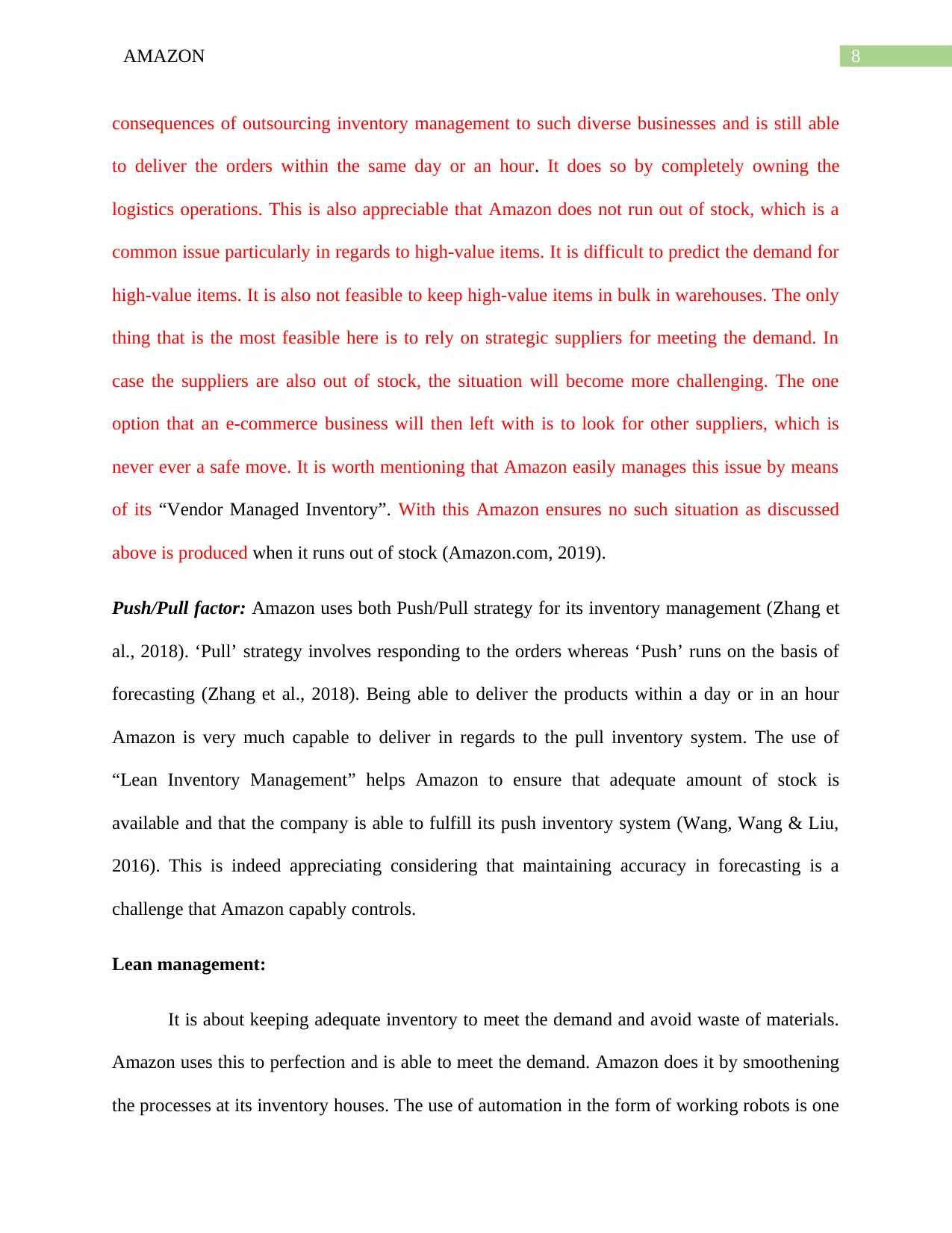
8AMAZON
consequences of outsourcing inventory management to such diverse businesses and is still able
to deliver the orders within the same day or an hour. It does so by completely owning the
logistics operations. This is also appreciable that Amazon does not run out of stock, which is a
common issue particularly in regards to high-value items. It is difficult to predict the demand for
high-value items. It is also not feasible to keep high-value items in bulk in warehouses. The only
thing that is the most feasible here is to rely on strategic suppliers for meeting the demand. In
case the suppliers are also out of stock, the situation will become more challenging. The one
option that an e-commerce business will then left with is to look for other suppliers, which is
never ever a safe move. It is worth mentioning that Amazon easily manages this issue by means
of its “Vendor Managed Inventory”. With this Amazon ensures no such situation as discussed
above is produced when it runs out of stock (Amazon.com, 2019).
Push/Pull factor: Amazon uses both Push/Pull strategy for its inventory management (Zhang et
al., 2018). ‘Pull’ strategy involves responding to the orders whereas ‘Push’ runs on the basis of
forecasting (Zhang et al., 2018). Being able to deliver the products within a day or in an hour
Amazon is very much capable to deliver in regards to the pull inventory system. The use of
“Lean Inventory Management” helps Amazon to ensure that adequate amount of stock is
available and that the company is able to fulfill its push inventory system (Wang, Wang & Liu,
2016). This is indeed appreciating considering that maintaining accuracy in forecasting is a
challenge that Amazon capably controls.
Lean management:
It is about keeping adequate inventory to meet the demand and avoid waste of materials.
Amazon uses this to perfection and is able to meet the demand. Amazon does it by smoothening
the processes at its inventory houses. The use of automation in the form of working robots is one
consequences of outsourcing inventory management to such diverse businesses and is still able
to deliver the orders within the same day or an hour. It does so by completely owning the
logistics operations. This is also appreciable that Amazon does not run out of stock, which is a
common issue particularly in regards to high-value items. It is difficult to predict the demand for
high-value items. It is also not feasible to keep high-value items in bulk in warehouses. The only
thing that is the most feasible here is to rely on strategic suppliers for meeting the demand. In
case the suppliers are also out of stock, the situation will become more challenging. The one
option that an e-commerce business will then left with is to look for other suppliers, which is
never ever a safe move. It is worth mentioning that Amazon easily manages this issue by means
of its “Vendor Managed Inventory”. With this Amazon ensures no such situation as discussed
above is produced when it runs out of stock (Amazon.com, 2019).
Push/Pull factor: Amazon uses both Push/Pull strategy for its inventory management (Zhang et
al., 2018). ‘Pull’ strategy involves responding to the orders whereas ‘Push’ runs on the basis of
forecasting (Zhang et al., 2018). Being able to deliver the products within a day or in an hour
Amazon is very much capable to deliver in regards to the pull inventory system. The use of
“Lean Inventory Management” helps Amazon to ensure that adequate amount of stock is
available and that the company is able to fulfill its push inventory system (Wang, Wang & Liu,
2016). This is indeed appreciating considering that maintaining accuracy in forecasting is a
challenge that Amazon capably controls.
Lean management:
It is about keeping adequate inventory to meet the demand and avoid waste of materials.
Amazon uses this to perfection and is able to meet the demand. Amazon does it by smoothening
the processes at its inventory houses. The use of automation in the form of working robots is one
⊘ This is a preview!⊘
Do you want full access?
Subscribe today to unlock all pages.

Trusted by 1+ million students worldwide
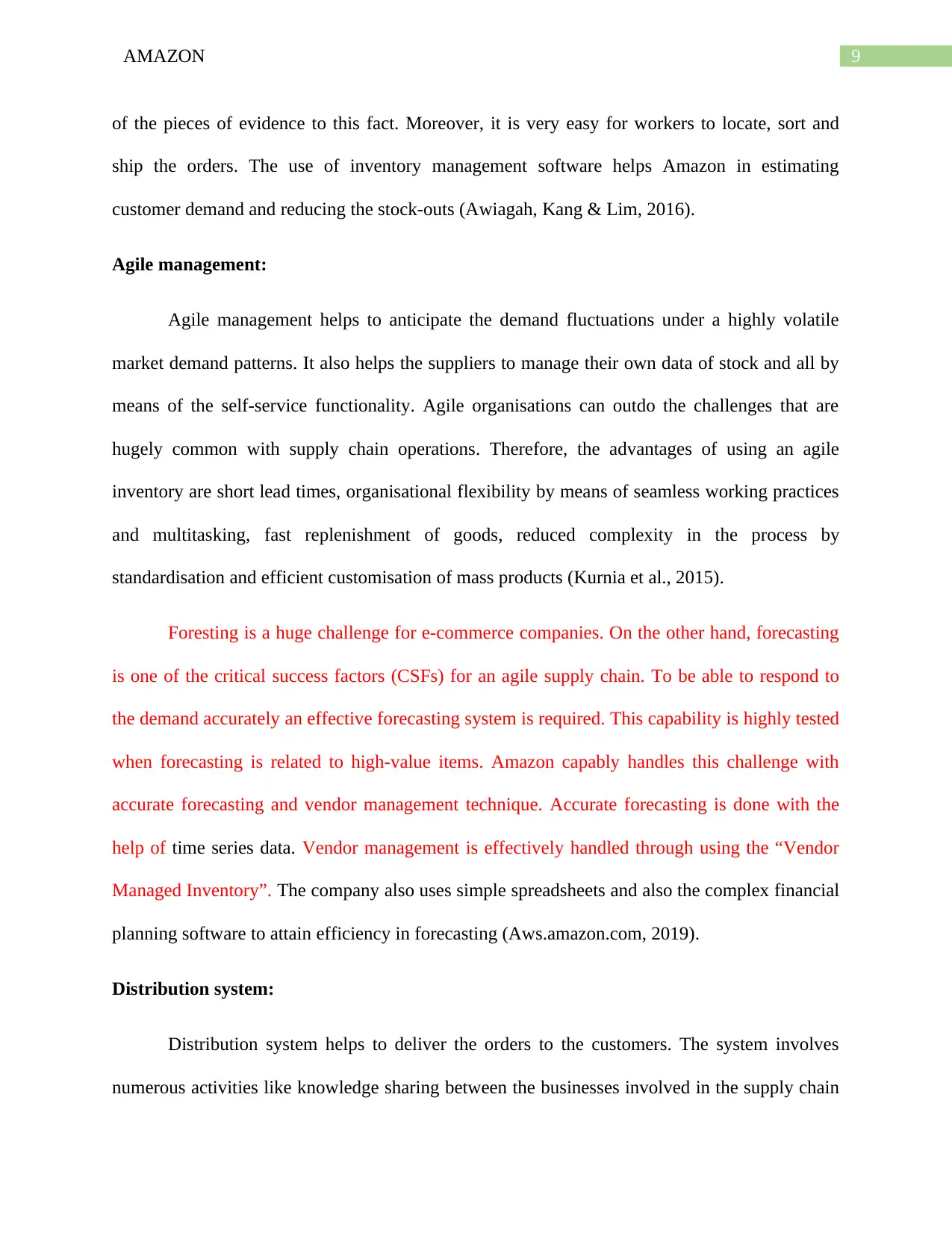
9AMAZON
of the pieces of evidence to this fact. Moreover, it is very easy for workers to locate, sort and
ship the orders. The use of inventory management software helps Amazon in estimating
customer demand and reducing the stock-outs (Awiagah, Kang & Lim, 2016).
Agile management:
Agile management helps to anticipate the demand fluctuations under a highly volatile
market demand patterns. It also helps the suppliers to manage their own data of stock and all by
means of the self-service functionality. Agile organisations can outdo the challenges that are
hugely common with supply chain operations. Therefore, the advantages of using an agile
inventory are short lead times, organisational flexibility by means of seamless working practices
and multitasking, fast replenishment of goods, reduced complexity in the process by
standardisation and efficient customisation of mass products (Kurnia et al., 2015).
Foresting is a huge challenge for e-commerce companies. On the other hand, forecasting
is one of the critical success factors (CSFs) for an agile supply chain. To be able to respond to
the demand accurately an effective forecasting system is required. This capability is highly tested
when forecasting is related to high-value items. Amazon capably handles this challenge with
accurate forecasting and vendor management technique. Accurate forecasting is done with the
help of time series data. Vendor management is effectively handled through using the “Vendor
Managed Inventory”. The company also uses simple spreadsheets and also the complex financial
planning software to attain efficiency in forecasting (Aws.amazon.com, 2019).
Distribution system:
Distribution system helps to deliver the orders to the customers. The system involves
numerous activities like knowledge sharing between the businesses involved in the supply chain
of the pieces of evidence to this fact. Moreover, it is very easy for workers to locate, sort and
ship the orders. The use of inventory management software helps Amazon in estimating
customer demand and reducing the stock-outs (Awiagah, Kang & Lim, 2016).
Agile management:
Agile management helps to anticipate the demand fluctuations under a highly volatile
market demand patterns. It also helps the suppliers to manage their own data of stock and all by
means of the self-service functionality. Agile organisations can outdo the challenges that are
hugely common with supply chain operations. Therefore, the advantages of using an agile
inventory are short lead times, organisational flexibility by means of seamless working practices
and multitasking, fast replenishment of goods, reduced complexity in the process by
standardisation and efficient customisation of mass products (Kurnia et al., 2015).
Foresting is a huge challenge for e-commerce companies. On the other hand, forecasting
is one of the critical success factors (CSFs) for an agile supply chain. To be able to respond to
the demand accurately an effective forecasting system is required. This capability is highly tested
when forecasting is related to high-value items. Amazon capably handles this challenge with
accurate forecasting and vendor management technique. Accurate forecasting is done with the
help of time series data. Vendor management is effectively handled through using the “Vendor
Managed Inventory”. The company also uses simple spreadsheets and also the complex financial
planning software to attain efficiency in forecasting (Aws.amazon.com, 2019).
Distribution system:
Distribution system helps to deliver the orders to the customers. The system involves
numerous activities like knowledge sharing between the businesses involved in the supply chain
Paraphrase This Document
Need a fresh take? Get an instant paraphrase of this document with our AI Paraphraser
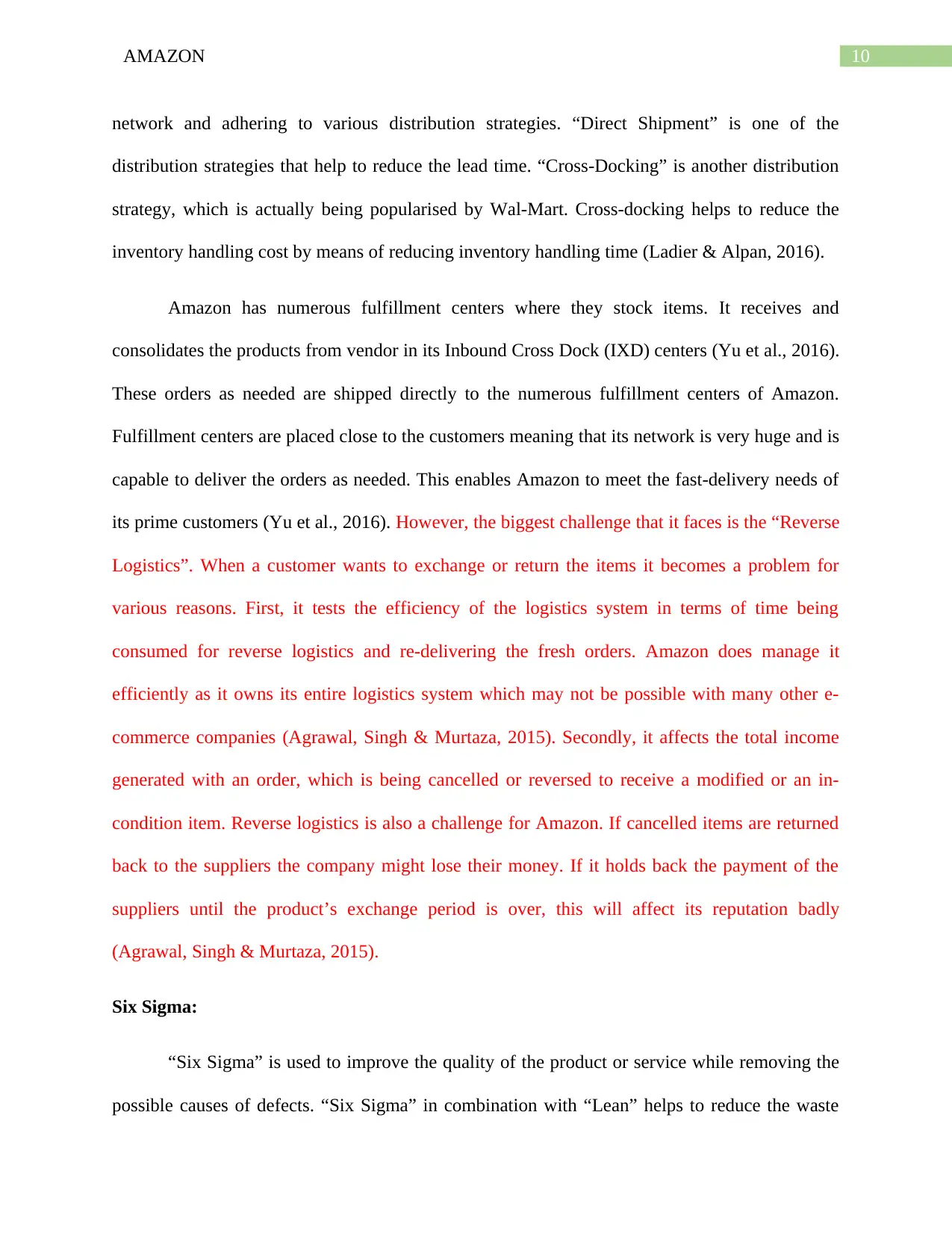
10AMAZON
network and adhering to various distribution strategies. “Direct Shipment” is one of the
distribution strategies that help to reduce the lead time. “Cross-Docking” is another distribution
strategy, which is actually being popularised by Wal-Mart. Cross-docking helps to reduce the
inventory handling cost by means of reducing inventory handling time (Ladier & Alpan, 2016).
Amazon has numerous fulfillment centers where they stock items. It receives and
consolidates the products from vendor in its Inbound Cross Dock (IXD) centers (Yu et al., 2016).
These orders as needed are shipped directly to the numerous fulfillment centers of Amazon.
Fulfillment centers are placed close to the customers meaning that its network is very huge and is
capable to deliver the orders as needed. This enables Amazon to meet the fast-delivery needs of
its prime customers (Yu et al., 2016). However, the biggest challenge that it faces is the “Reverse
Logistics”. When a customer wants to exchange or return the items it becomes a problem for
various reasons. First, it tests the efficiency of the logistics system in terms of time being
consumed for reverse logistics and re-delivering the fresh orders. Amazon does manage it
efficiently as it owns its entire logistics system which may not be possible with many other e-
commerce companies (Agrawal, Singh & Murtaza, 2015). Secondly, it affects the total income
generated with an order, which is being cancelled or reversed to receive a modified or an in-
condition item. Reverse logistics is also a challenge for Amazon. If cancelled items are returned
back to the suppliers the company might lose their money. If it holds back the payment of the
suppliers until the product’s exchange period is over, this will affect its reputation badly
(Agrawal, Singh & Murtaza, 2015).
Six Sigma:
“Six Sigma” is used to improve the quality of the product or service while removing the
possible causes of defects. “Six Sigma” in combination with “Lean” helps to reduce the waste
network and adhering to various distribution strategies. “Direct Shipment” is one of the
distribution strategies that help to reduce the lead time. “Cross-Docking” is another distribution
strategy, which is actually being popularised by Wal-Mart. Cross-docking helps to reduce the
inventory handling cost by means of reducing inventory handling time (Ladier & Alpan, 2016).
Amazon has numerous fulfillment centers where they stock items. It receives and
consolidates the products from vendor in its Inbound Cross Dock (IXD) centers (Yu et al., 2016).
These orders as needed are shipped directly to the numerous fulfillment centers of Amazon.
Fulfillment centers are placed close to the customers meaning that its network is very huge and is
capable to deliver the orders as needed. This enables Amazon to meet the fast-delivery needs of
its prime customers (Yu et al., 2016). However, the biggest challenge that it faces is the “Reverse
Logistics”. When a customer wants to exchange or return the items it becomes a problem for
various reasons. First, it tests the efficiency of the logistics system in terms of time being
consumed for reverse logistics and re-delivering the fresh orders. Amazon does manage it
efficiently as it owns its entire logistics system which may not be possible with many other e-
commerce companies (Agrawal, Singh & Murtaza, 2015). Secondly, it affects the total income
generated with an order, which is being cancelled or reversed to receive a modified or an in-
condition item. Reverse logistics is also a challenge for Amazon. If cancelled items are returned
back to the suppliers the company might lose their money. If it holds back the payment of the
suppliers until the product’s exchange period is over, this will affect its reputation badly
(Agrawal, Singh & Murtaza, 2015).
Six Sigma:
“Six Sigma” is used to improve the quality of the product or service while removing the
possible causes of defects. “Six Sigma” in combination with “Lean” helps to reduce the waste
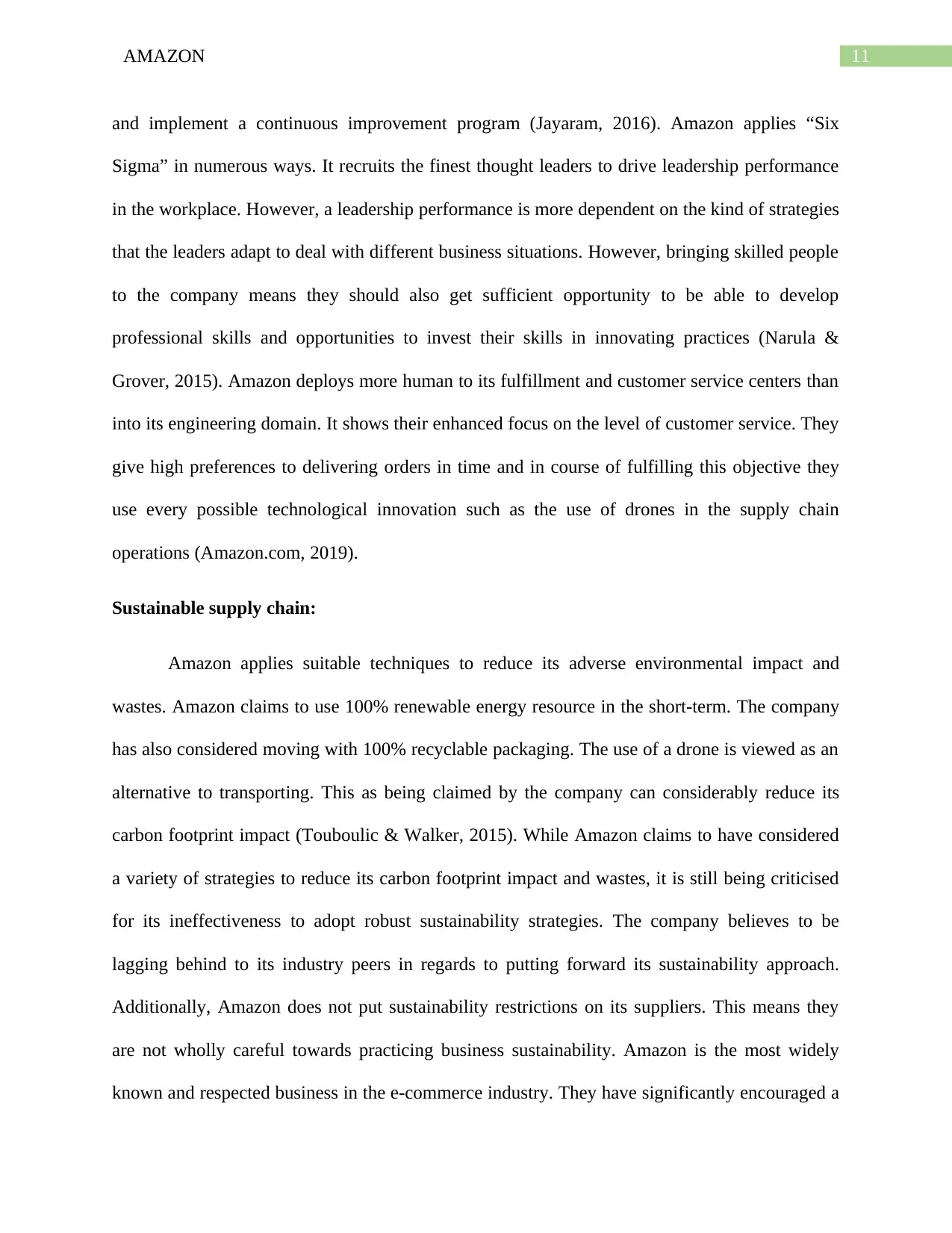
11AMAZON
and implement a continuous improvement program (Jayaram, 2016). Amazon applies “Six
Sigma” in numerous ways. It recruits the finest thought leaders to drive leadership performance
in the workplace. However, a leadership performance is more dependent on the kind of strategies
that the leaders adapt to deal with different business situations. However, bringing skilled people
to the company means they should also get sufficient opportunity to be able to develop
professional skills and opportunities to invest their skills in innovating practices (Narula &
Grover, 2015). Amazon deploys more human to its fulfillment and customer service centers than
into its engineering domain. It shows their enhanced focus on the level of customer service. They
give high preferences to delivering orders in time and in course of fulfilling this objective they
use every possible technological innovation such as the use of drones in the supply chain
operations (Amazon.com, 2019).
Sustainable supply chain:
Amazon applies suitable techniques to reduce its adverse environmental impact and
wastes. Amazon claims to use 100% renewable energy resource in the short-term. The company
has also considered moving with 100% recyclable packaging. The use of a drone is viewed as an
alternative to transporting. This as being claimed by the company can considerably reduce its
carbon footprint impact (Touboulic & Walker, 2015). While Amazon claims to have considered
a variety of strategies to reduce its carbon footprint impact and wastes, it is still being criticised
for its ineffectiveness to adopt robust sustainability strategies. The company believes to be
lagging behind to its industry peers in regards to putting forward its sustainability approach.
Additionally, Amazon does not put sustainability restrictions on its suppliers. This means they
are not wholly careful towards practicing business sustainability. Amazon is the most widely
known and respected business in the e-commerce industry. They have significantly encouraged a
and implement a continuous improvement program (Jayaram, 2016). Amazon applies “Six
Sigma” in numerous ways. It recruits the finest thought leaders to drive leadership performance
in the workplace. However, a leadership performance is more dependent on the kind of strategies
that the leaders adapt to deal with different business situations. However, bringing skilled people
to the company means they should also get sufficient opportunity to be able to develop
professional skills and opportunities to invest their skills in innovating practices (Narula &
Grover, 2015). Amazon deploys more human to its fulfillment and customer service centers than
into its engineering domain. It shows their enhanced focus on the level of customer service. They
give high preferences to delivering orders in time and in course of fulfilling this objective they
use every possible technological innovation such as the use of drones in the supply chain
operations (Amazon.com, 2019).
Sustainable supply chain:
Amazon applies suitable techniques to reduce its adverse environmental impact and
wastes. Amazon claims to use 100% renewable energy resource in the short-term. The company
has also considered moving with 100% recyclable packaging. The use of a drone is viewed as an
alternative to transporting. This as being claimed by the company can considerably reduce its
carbon footprint impact (Touboulic & Walker, 2015). While Amazon claims to have considered
a variety of strategies to reduce its carbon footprint impact and wastes, it is still being criticised
for its ineffectiveness to adopt robust sustainability strategies. The company believes to be
lagging behind to its industry peers in regards to putting forward its sustainability approach.
Additionally, Amazon does not put sustainability restrictions on its suppliers. This means they
are not wholly careful towards practicing business sustainability. Amazon is the most widely
known and respected business in the e-commerce industry. They have significantly encouraged a
⊘ This is a preview!⊘
Do you want full access?
Subscribe today to unlock all pages.

Trusted by 1+ million students worldwide
1 out of 17
Related Documents
Your All-in-One AI-Powered Toolkit for Academic Success.
+13062052269
info@desklib.com
Available 24*7 on WhatsApp / Email
![[object Object]](/_next/static/media/star-bottom.7253800d.svg)
Unlock your academic potential
Copyright © 2020–2025 A2Z Services. All Rights Reserved. Developed and managed by ZUCOL.




